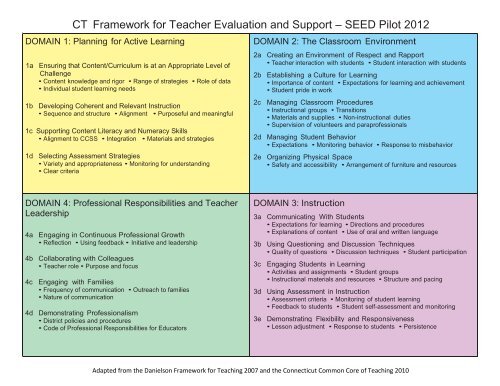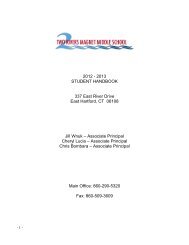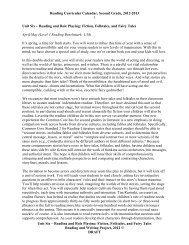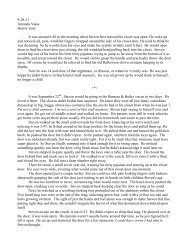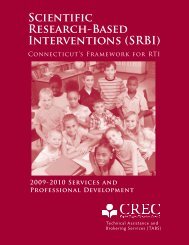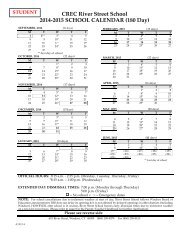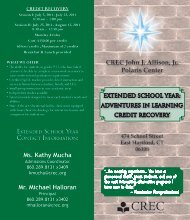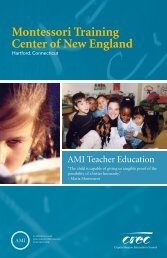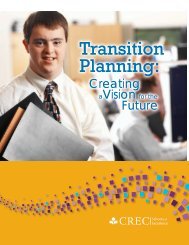CT Framework for Teacher Evaluation and Support – SEED Pilot 2012
CT Framework for Teacher Evaluation and Support – SEED Pilot 2012
CT Framework for Teacher Evaluation and Support – SEED Pilot 2012
Create successful ePaper yourself
Turn your PDF publications into a flip-book with our unique Google optimized e-Paper software.
<strong>CT</strong> <strong>Framework</strong> <strong>for</strong> <strong>Teacher</strong> <strong>Evaluation</strong> <strong>and</strong> <strong>Support</strong> <strong>–</strong> <strong>SEED</strong> <strong>Pilot</strong> <strong>2012</strong><br />
DOMAIN 1: Planning <strong>for</strong> Active Learning<br />
1a Ensuring that Content/Curriculum is at an Appropriate Level of<br />
Challenge<br />
• Content knowledge <strong>and</strong> rigor • Range of strategies • Role of data<br />
• Individual student learning needs<br />
1b Developing Coherent <strong>and</strong> Relevant Instruction<br />
• Sequence <strong>and</strong> structure • Alignment • Purposeful <strong>and</strong> meaningful<br />
1c <strong>Support</strong>ing Content Literacy <strong>and</strong> Numeracy Skills<br />
• Alignment to CCSS • Integration • Materials <strong>and</strong> strategies<br />
1d Selecting Assessment Strategies<br />
• Variety <strong>and</strong> appropriateness • Monitoring <strong>for</strong> underst<strong>and</strong>ing<br />
• Clear criteria<br />
DOMAIN 2: The Classroom Environment<br />
2a Creating an Environment of Respect <strong>and</strong> Rapport<br />
• <strong>Teacher</strong> interaction with students • Student interaction with students<br />
2b Establishing a Culture <strong>for</strong> Learning<br />
• Importance of content • Expectations <strong>for</strong> learning <strong>and</strong> achievement<br />
• Student pride in work<br />
2c Managing Classroom Procedures<br />
• Instructional groups • Transitions<br />
• Materials <strong>and</strong> supplies • Non-instructional duties<br />
• Supervision of volunteers <strong>and</strong> paraprofessionals<br />
2d Managing Student Behavior<br />
• Expectations • Monitoring behavior • Response to misbehavior<br />
2e Organizing Physical Space<br />
• Safety <strong>and</strong> accessibility • Arrangement of furniture <strong>and</strong> resources<br />
DOMAIN 4: Professional Responsibilities <strong>and</strong> <strong>Teacher</strong><br />
Leadership<br />
4a Engaging in Continuous Professional Growth<br />
• Reflection • Using feedback • Initiative <strong>and</strong> leadership<br />
4b Collaborating with Colleagues<br />
• <strong>Teacher</strong> role • Purpose <strong>and</strong> focus<br />
4c Engaging with Families<br />
• Frequency of communication • Outreach to families<br />
• Nature of communication<br />
4d Demonstrating Professionalism<br />
• District policies <strong>and</strong> procedures<br />
• Code of Professional Responsibilities <strong>for</strong> Educators<br />
DOMAIN 3: Instruction<br />
3a Communicating With Students<br />
• Expectations <strong>for</strong> learning • Directions <strong>and</strong> procedures<br />
• Explanations of content • Use of oral <strong>and</strong> written language<br />
3b Using Questioning <strong>and</strong> Discussion Techniques<br />
• Quality of questions • Discussion techniques • Student participation<br />
3c Engaging Students in Learning<br />
• Activities <strong>and</strong> assignments • Student groups<br />
• Instructional materials <strong>and</strong> resources • Structure <strong>and</strong> pacing<br />
3d Using Assessment in Instruction<br />
• Assessment criteria • Monitoring of student learning<br />
• Feedback to students • Student self-assessment <strong>and</strong> monitoring<br />
3e Demonstrating Flexibility <strong>and</strong> Responsiveness<br />
• Lesson adjustment • Response to students • Persistence<br />
Adapted from the Danielson <strong>Framework</strong> <strong>for</strong> Teaching 2007 <strong>and</strong> the Connecticut Common Core of Teaching 2010
CLARIFYING<br />
Clarifying communicates that the<br />
listener has…<br />
HEARD what the speaker said BUT does<br />
NOT fully UNDERSTAND what was said.<br />
Clarifying involves ASKING A QUESTION<br />
(direct or implied) to:<br />
1. Gather more in<strong>for</strong>mation<br />
2. Discover the meaning of the language used<br />
3. Get clarity about the speaker’s reasoning<br />
4. Seek connections between ideas<br />
5. Develop or maintain a focus<br />
Some possible clarifying stems include the<br />
following:<br />
Say a little more about…?<br />
Can you clarify what you mean by …?<br />
Share an example of …<br />
So, are you saying/suggesting…?<br />
In what ways is that idea like (or different from) …<br />
When you say<br />
that have <strong>for</strong> you?<br />
INSTRU<strong>CT</strong>IONAL STEMS<br />
What we know is…<br />
, what meaning does<br />
The research around this shows that…<br />
A couple of things to keep in mind…<br />
Some teachers have tried….<br />
There are number of approaches…<br />
Sometimes it’s helpful if…<br />
PARAPHRASING<br />
Paraphrasing communicates that the<br />
listener has…<br />
HEARD what the speaker said,<br />
UNDERSTOOD what was said, <strong>and</strong> CARES<br />
Paraphrasing involves either:<br />
RESTATING in your own words, or<br />
SUMMARIZING<br />
Some possible paraphrasing stems include<br />
the following:<br />
So …<br />
In other words ...<br />
You are saying …<br />
You are feeling …<br />
Your opinion is …<br />
You’re considering several things ...<br />
A value or belief you have …<br />
NON JUDGMENTAL RESPONSES<br />
Build trust<br />
Promote an internal locus of control<br />
Encourage self-assessment<br />
Develop autonomy<br />
Foster risk-taking<br />
Possible examples:<br />
Identify what worked <strong>and</strong> why<br />
When you<br />
Encourage<br />
the student really<br />
It sounds like you have a number of ideas to try<br />
out! It’ll be exciting/interesting/great to see<br />
which works best <strong>for</strong> you!<br />
Ask the teacher to self-assess<br />
How do you think the lesson went <strong>and</strong> why?<br />
SUGGESTION STEMS<br />
One thing we’ve learned/noticed is… A couple of<br />
things to keep in mind… Several/some teachers<br />
have tried a couple of different things in this sort<br />
of situation <strong>and</strong> maybe one might work <strong>for</strong> you…<br />
What effective teachers seem to know about<br />
is<br />
…<br />
Something/some things to keep in mind when<br />
dealing with…<br />
Something you might consider trying is….<br />
There are a number of approaches…<br />
Sometimes it’s helpful if…<br />
Try following a suggestion with a question<br />
that invites the teacher to<br />
imagine/hypothesize how the idea might<br />
work in his/her context.<br />
How might that look in your classroom?<br />
To what extent might that be effective in your<br />
situation/with your students?<br />
What do you imagine might happen if you were<br />
to try with your class?<br />
Which of these ideas might work best in your<br />
classroom (with your students)?<br />
MEDIATIONAL QUESTONS<br />
HYPOTHESIZE what might happen<br />
ANALYZE what worked <strong>and</strong> what didn’t<br />
IMAGINE possibilities<br />
COMPARE AND CONTRAST what was<br />
planned with what happened:<br />
What might be some other ways …?<br />
What would it look like if …?<br />
What might happen if you …?<br />
What do you consider when you decide …?


